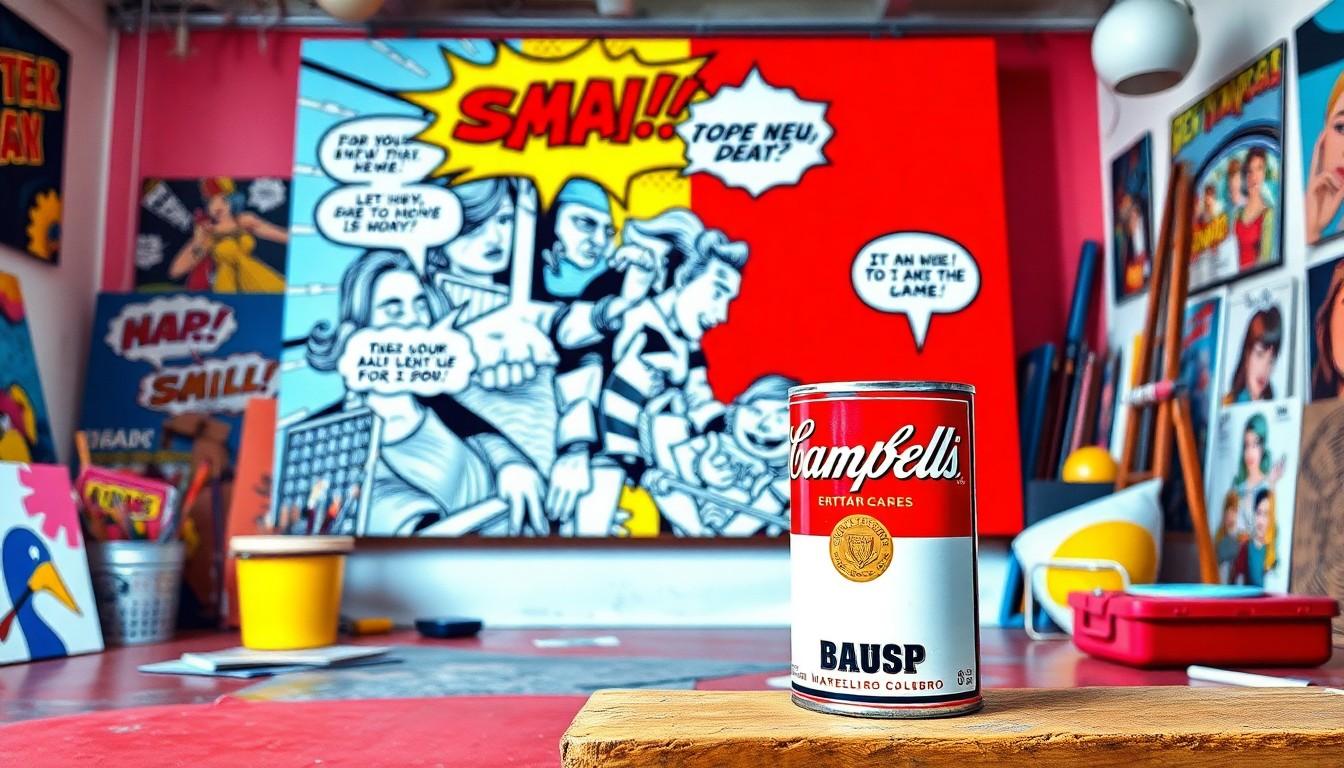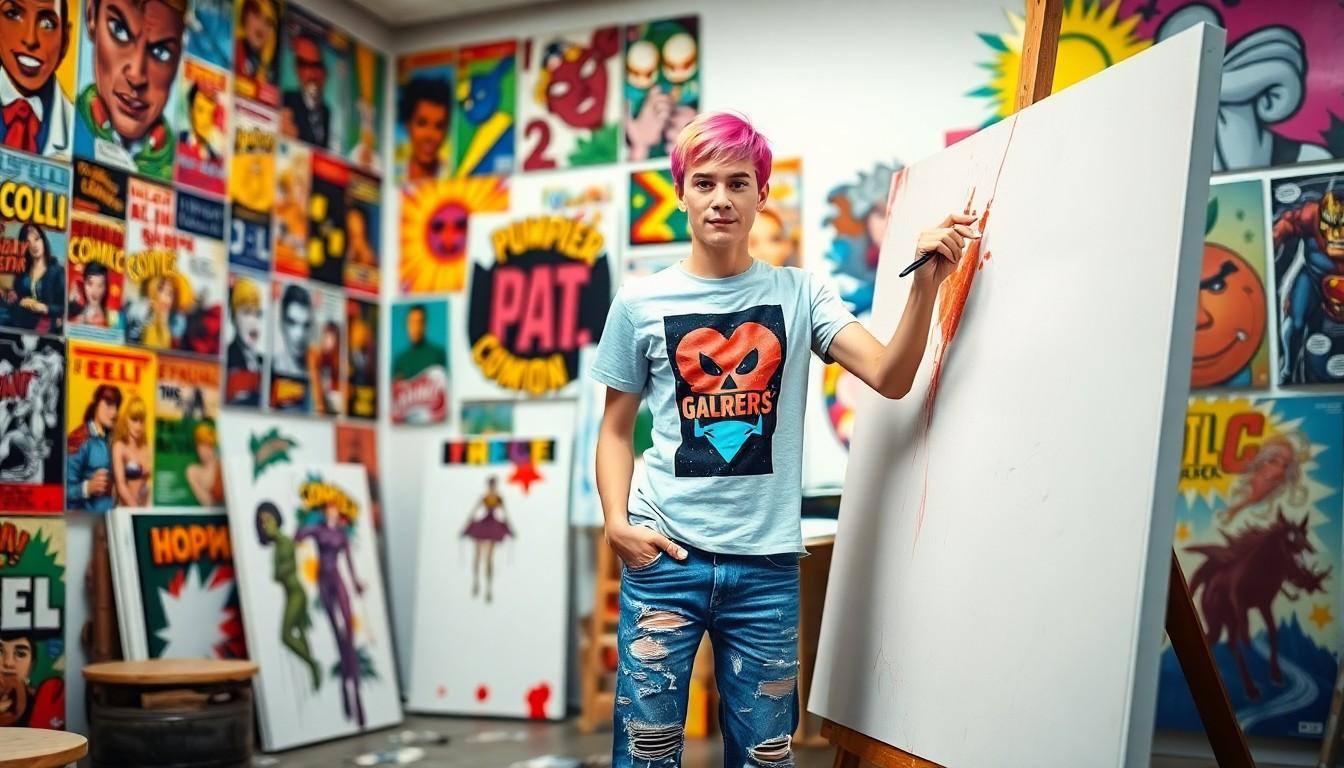In a world where art meets pop culture, one artist stands out like a superhero in a sea of capes. This creative genius didn’t just dabble in paint; they dove headfirst into the vibrant realms of comic books and commercial art, transforming everyday visuals into iconic masterpieces. If you’ve ever wondered who took inspiration from the colorful pages of comic books and the flashy ads that scream for attention, you’re in for a treat.
Which Pop Artist Took Inspiration from Comic Books and Commercial Art?
Pop art emerged in the mid-20th century as a vibrant movement that merged fine art with popular culture. Artists sought to challenge traditional boundaries by drawing inspiration from commercial sources. Comic books, advertisements, and consumer products served as foundational elements for this creative expression.
Roy Lichtenstein and Andy Warhol became some of the most recognized figures within the pop art genre. Lichtenstein’s work often mirrored the visual style of comic strips, showcasing bold lines and vivid colors. His pieces transformed everyday narratives into prominent artworks, captivating audiences with their visual impact.
Warhol, on the other hand, used commercial techniques to blur the lines between art and consumerism. His famous Campbell’s Soup Cans exemplified this approach, making commonplace items the subject of high art. Warhol’s fascination with celebrity culture also played a crucial role in the development of the movement, as he showcased icons like Marilyn Monroe and Elvis Presley in his striking works.
The influence of advertising on pop art cannot be overstated. Artists incorporated familiar brands and logos, reflecting society’s growing obsession with mass media and consumer goods. This method highlighted both the allure and the superficiality of consumer culture.
Pop art continues to inspire contemporary artists, who explore its themes in new and innovative ways. By integrating elements from the world around them, they honor the tradition started by the pioneers of the movement. These routes taken from comic books and commercial art shape the ongoing evolution of pop art, establishing its lasting legacy in the art world.
Key Influences on Pop Art
Pop art emerged prominently in the mid-20th century, incorporating elements from various cultural segments, notably comic books and commercial art. These influences shaped the movement’s aesthetic and thematic expressions significantly.
Comic Books
Comic books played a critical role in inspiring pop artists. They utilized vibrant colors and bold lines to captivate audiences. Artists like Roy Lichtenstein directly drew from the visual language of comic strips. His pieces often included speech bubbles and dramatic narratives, combining everyday stories with high art. This crossover elevated comic art, reflecting cultural dialogues while challenging traditional art forms. Lichtenstein’s method of reproducing comic imagery in fine art sparked discussions about authenticity and originality within the art world.
Commercial Art
Commercial art also significantly impacted the pop art movement. Artists actively borrowed imagery from advertisements, unveiling a commentary on consumer culture. Andy Warhol’s iconic Campbell’s Soup Cans epitomized this trend, transforming mundane products into objects of fascination. Warhol’s repeated motifs highlighted the mass production and commodification of art itself. This integration of commercial elements encouraged a critical examination of consumerism and its influence on daily life. By merging commercial visual language with fine art, pop artists opened avenues for exploring identity and societal values.
Prominent Pop Artists
Several pop artists drew significant inspiration from comic books and commercial art, reshaping both art and culture through their innovative approaches.
Roy Lichtenstein
Roy Lichtenstein is celebrated for his distinctive style that emulates comic strip aesthetics. His artwork features bold outlines and vivid primary colors, often recontextualizing classic comic narratives. Works like “Whaam!” transformed everyday visuals into monumental pieces, provoking thought about art’s boundaries. The artist employed a technique called Ben-Day dots, mimicking the printing process used in comics, which raised discussions surrounding originality. Lichtenstein’s contributions underscore how comic art can challenge fine art traditions and influence contemporary practices.
Andy Warhol
Andy Warhol is known for his groundbreaking fusion of art and consumer culture. Iconic works such as the Campbell’s Soup Cans and Marilyn Monroe portraits exemplify his fascination with branding and fame. Warhol’s use of commercial printing methods, like silkscreening, blurred the line between art and mass production. His art responds to post-war consumerism while critiquing the superficiality of celebrity culture. Through repetition and bold imagery, Warhol’s pieces invite viewers to reflect on their relationship with mass media and the commodification of art.
Claes Oldenburg
Claes Oldenburg made a significant impact with his large-scale sculptures that playfully engage with everyday objects. His work often repurposes mundane items, like hamburgers or ice cream cones, framing them as art. Oldenburg’s installations challenge conventional perceptions and invite humor into the art world. By creating soft sculptures and immersive installations, he reinterprets the relationship between art and consumer products. The whimsical nature of Oldenburg’s work emphasizes the intersection of pop culture and fine art, inspiring viewers to appreciate the absurdity of consumerism.
Impact of Comic Books and Commercial Art on Pop Artists
Comic books and commercial art significantly shaped the pop art movement. Artists like Roy Lichtenstein drew upon the bold colors and graphic storytelling of comic strips. Vivid imagery became a hallmark of Lichtenstein’s art, particularly through his use of Ben-Day dots to recreate the look of printed comics.
Andy Warhol, another influential pop artist, integrated commercial art into his works seamlessly. His iconic Campbell’s Soup Cans transformed an everyday product into a cultural statement, challenging perceptions of art’s purpose. Warhol’s approach highlighted the intersection of consumerism and art, prompting viewers to reconsider the value of mass-produced items.
Both Lichtenstein and Warhol inspired a dialogue about originality and appropriation. Their work raised questions about what defines art in an era dominated by commercial influences. Through their creations, these artists blurred the lines between high art and popular culture, making art more accessible to the public.
Commercial art’s impact extends beyond specific artists. The use of advertising techniques in fine art provokes critical reflections on societal values and identity. By incorporating familiar brand imagery, pop artists invite viewers to analyze their own relationship with consumer culture.
The vibrant aesthetics of comic books and advertising continue to influence contemporary artists. Today, many creators reference the pop art movement to connect with their audiences. This ongoing legacy ensures that the dialogue surrounding art and commercialism remains relevant in artistic expressions.
Overview of Pop Art
The influence of comic books and commercial art on pop artists like Roy Lichtenstein and Andy Warhol can’t be overstated. Their innovative approaches not only redefined the boundaries of art but also challenged societal perceptions of consumer culture. By merging vibrant imagery with everyday themes, these artists created a dynamic dialogue that resonates today.
Their work continues to inspire contemporary creators, ensuring that the intersection of art and pop culture remains a vital topic in the art world. As the legacy of pop art evolves, its roots in comic and commercial aesthetics will always be a significant part of the conversation.


